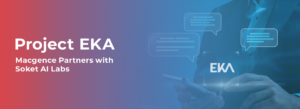- What is Data Annotation?
- What are Data Annotation / Labeling Tools?
- Why is Data Annotation Important?
- Steps in Data Annotation Process
- Types of Data Annotation
- Features of Data Annotation Tools
- Benefits of Data Annotation
- Challenges of Data Annotation
- Data Annotation in Specific Industries
- What Data Annotation Tool to Use (Build or not Build)?
- Best Practices for Data Annotation
- Difference Between Data Annotation and Data Labeling
- Conclusion
- Get Started with Macgence
- Frequently Asked Questions (FAQ’S)
A Brief Guide about the Data Annotation
Did you know data annotation holds the key to successful machine learning models? It’s a vital task that bridges the gap between raw data and AI comprehension. What exactly is data annotation, you ask? Well, it’s the process of labeling data to train algorithms. But why is it so crucial? Simply put, it’s the foundation on which machine learning thrives.
In this brief guide, we’ll dive into the importances. First, we’ll uncover the various types of data annotation. Then, we’ll explore why industries across the spectrum are banking on it. Of course, there are perks—benefits that extend beyond just correct predictions. But, like any path to success, challenges lurk too. Learn about the best practices that steer data annotation toward excellence. By the end, you’ll realize that the power of AI stems from a well annotated foundation. Let’s dive in!
What is Data Annotation?
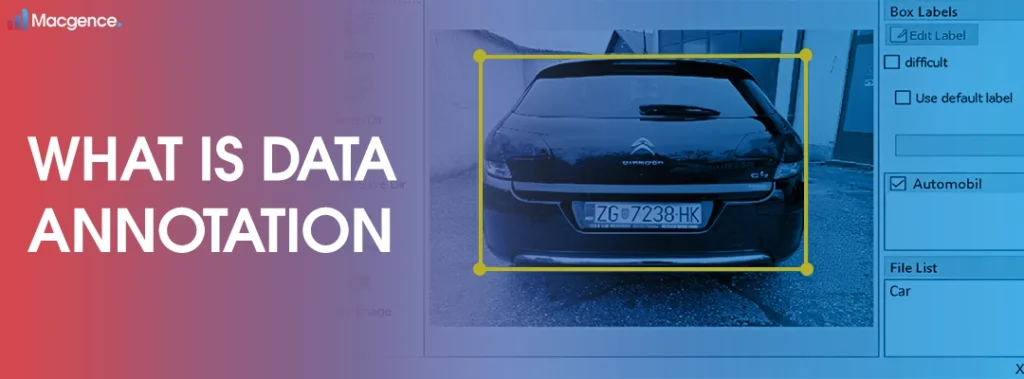
Data Annotation is the process of labeling or tagging data to provide meaningful information for machine learning algorithms. It involves adding annotations or meta data to raw data, making it understandable for computers. By doing this, AI and ML models can learn from the labeled data to recognize patterns and make predictions.
In these, various types of data can be label, such as images, text, videos, audio, and sensor data. This label can take the form of bounding boxes, semantic segmentation, image classification tags, named entity recognition, or sentiment analysis labels.
What are Data Annotation / Labeling Tools?
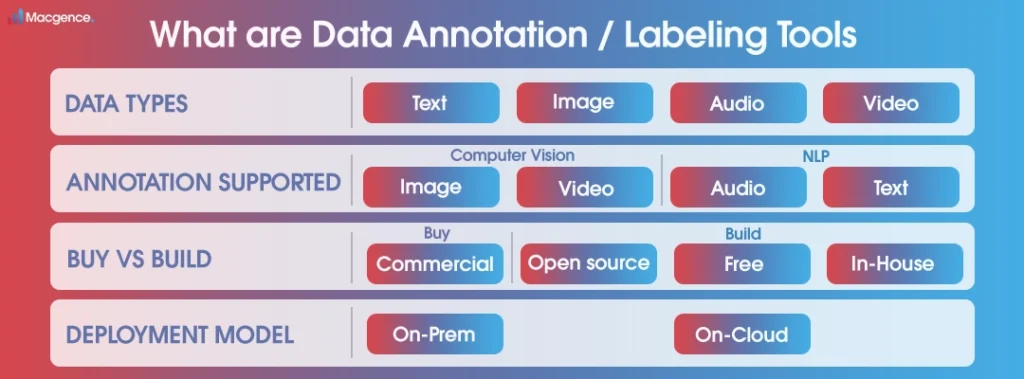
If we’re to consider what a tool is, we can say a tool is anything that helps facilitate a work process. Now, tools are anything that can help experts, specialists, tag or label all kinds of data sets.
However, data annotators need specific tools; these tools can be a portal or a platform that they can work on any type of dataset. Since many companies work with data ensuring that the platform they use to annotate their data must be secured. By opting for cloud based solutions can help protect data from loss.
Furthermore, data annotation tools softwares can be built from scratch to fit the needs of the company or it can be send to external vendors. Either way, the tools should offer features to annotate most data sets.
Why is Data Annotation Important?
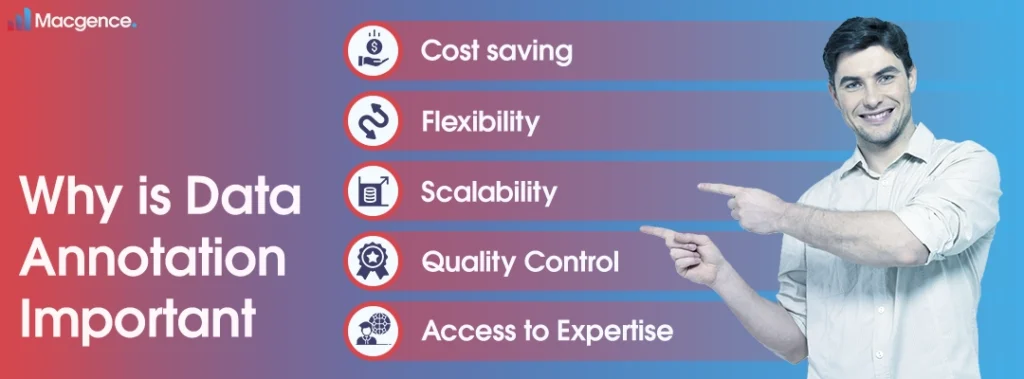
It is crucial for AI and ML models to learn and make accurate predictions. It provides meaningful information by label or tagging raw data. This helps computers understand the data, allowing models to recognize patterns and make predictions.
Firstly, it improves the accuracy and performance of machine learning models. By annotating data, models can learn from the labeled examples and generalize to new, unseen data.
Secondly, it is particularly important in tasks such as image recognition. In this context, objects or regions of interest within images are label with bounding boxes or segmentation masks. These annotations serve as ground truth for training deep learning models, helping them identify and classify objects accurately in images.
Moreover, in natural language processing (NLP), it plays a crucial role. Named entity recognition (NER) is a process where entities like names, dates, and locations are label within a text. Additionally, sentiment analysis labels help determine the sentiment expressed in a piece of text, allowing NLP models to understand the emotions and opinions of users in sentiment analysis applications.
Steps in Data Annotation Process
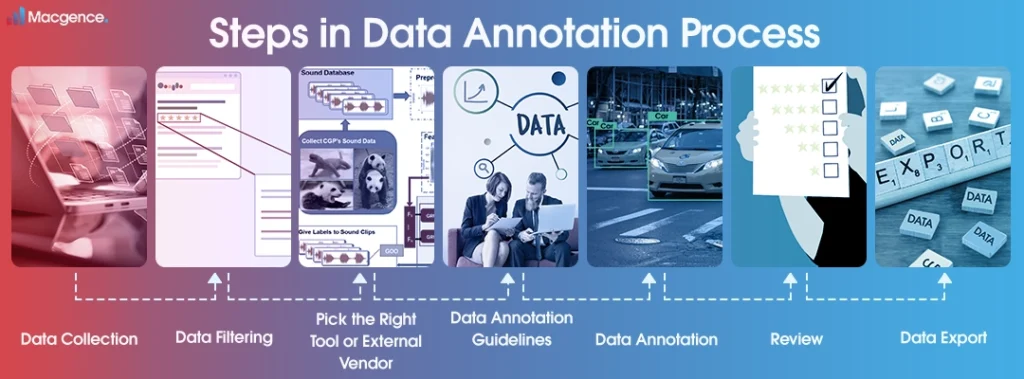
Before annotation of data, there are certain steps that must be done to achieve high quality and accurate data for training ML models. Here are the steps involve:
- Data Collection: Data Collection is the initial stage in the data annotation process. It involves gathering relevant data from various sources. These data can be structured, semi structured and unstructured, consisting of text, images, videos, or audio files.
- Data Filtering: At this stage, the data is being filter for easier analysis. This prepares the grounds for data annotation.
- Pick the Right Tool or External Vendor: There is a saying that the right tool in the hands of an average person can produce passable results but at the same time, in the hands of an expert, it can move the world. Selecting the right data annotation tool or vendor for your projects is a necessary step to consider.
- Data Annotation Guidelines: Setting certain rules and guidelines for annotators to abide by, will promote higher consistency and accuracy while they annotate the data.
- Data Annotation: the process of tagging the data by either human annotators, data annotation software, or both.
- Review: At this stage, the data annotation process is almost complete. Cross Checking for errors like misspellings, misinterpretation, etc to ensure accuracy and consistency of the annotated data.
- Data Export: After finalizing all procedures, exportation of the data is next. Choose the right format for the data to be export and then, move to the next phase of your project.
Types of Data Annotation
It comes in various types, each tailor to the specific needs of different AI and ML applications. Now, let’s look at some of the types:
1. Image Annotation
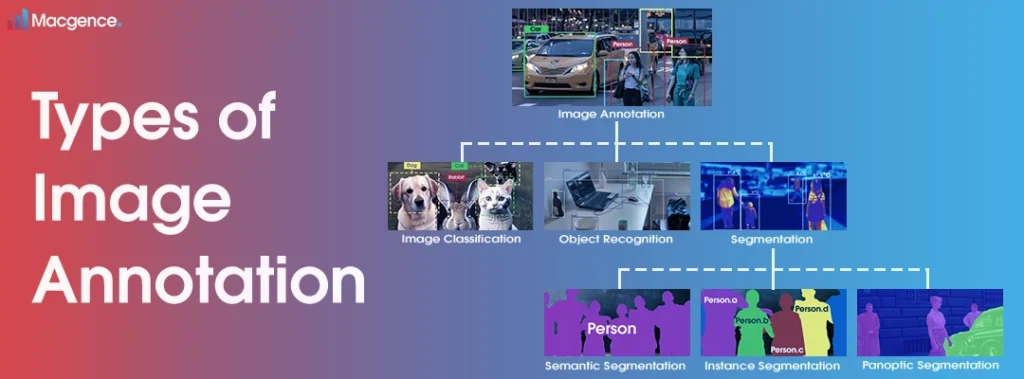
Image Annotation is a crucial technique use in computer vision to make data understandable for machine learning models. It involves adding meaningful labels to objects or regions of interest within images. By using bounding box annotation, annotators draw boxes around objects, defining their spatial extent. This annotation method is widely use in object detection tasks, enabling the model to recognize and locate specific objects within the image accurately. Image annotation plays a significant role in various applications, such as autonomous vehicles, surveillance systems, and industrial automation.
There are three basic types of image annotation:
- Image Classification: This is when AI models are train on annotated images. Further helping the AI models analyze and classify these images based on their contents.
- Object Recognition: Or rather Object Detection, is an advanced form of image classification. It is the process of accurately spotting certain objects in an image. Additionally, these objects can be a description of certain numbers, or the exact location of the objects. For example, an image of a city can be tagg, “Nightlife in New York” but in object detection, it has to spot the cars, people, buildings, bicycles, etc, in the image.
- Segmentation: This is a more advanced form of image annotation. It is when the image is broken down into different segments to help analyze and label the image. These broken down segments are called image objects. Actually, there are three types of segmentation:
- Semantic Segmentation: Is the process whereby the image objects are label according to certain features such as size and location.
- Instance Segmentation: This is when each object in the image is label according to their number and position.
- Panoptic Segmentation: The combination of both Semantic and Instance segmentation in labeling various objects in an image.
2. Text Annotation

Text Annotation is an important technique for making text data usable in natural language processing (NLP) tasks. Named Entity Recognition (NER) is a common text annotation method that find and classifies named entities such as names, dates, locations, and organizations within the text. Properly labeled NER data is critical in various NLP applications, including chatbots, sentiment analysis, and information retrieval.
Moreover, text data is not as straight forward as images and videos that can be easily understood by machines. Text data comes with a lot of biases or semantics. As we know, humans can precisely know when a phrase or sentence is full of sarcasm or humor. But machines will find this difficult—hence the need for text annotation.
3. Video Annotation
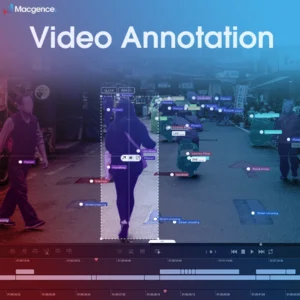
Video Annotation involves annotating objects or events within video data. Unlike image annotation, video annotation requires label objects across frames, considering the temporal aspect. This enables the model to understand the dynamics and movements in the video sequence accurately. Video annotation is crucial for training action recognition models used in surveillance, sports analysis, and human computer interaction. Ensuring accuracy in video annotations demands attention to detail and precise labeling of objects or events throughout the video.
4. Audio Annotation
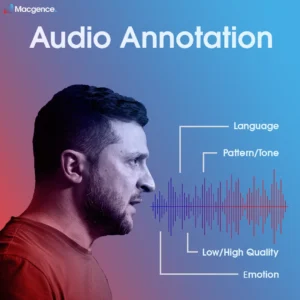
Audio Annotation is significant in speech and audio processing applications. Annotators mark specific events or segments within audio data, such as individual words or sounds in speech recognition tasks. Properly annotated audio data is critical in training speech recognition models, allowing them to convert spoken language into text accurately. However, audio annotation can be challenging, especially with noisy audio or overlapping sounds.
5. Sensor Data Annotation
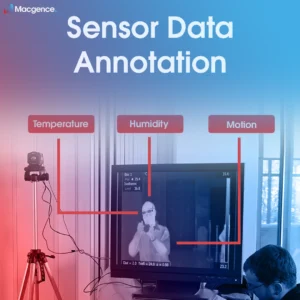
Sensor Data Annotation is relevant in applications involving IoT devices and sensor readings. Annotating sensor data allows AI models to understand and process data from various sensors effectively. In IoT applications, sensor data such as temperature, humidity, and motion are labeled to identify patterns, anomalies, or events. Sensor data annotation finds applications in anomaly detection tasks, where the model needs to recognize unusual behavior or deviations from expected sensor readings.
6. LiDAR Annotation

The full meaning of LiDAR is Light Detection and Ranging. It uses light in the form of laser pulses to measure and estimate the distance between objects. Actually, LiDAR became famous due to the rise of self driving cars. In fact, LiDar has improve the safety in self driving cars by constantly collecting data from the environment around the cars at every given point.
Features of Data Annotation Tools
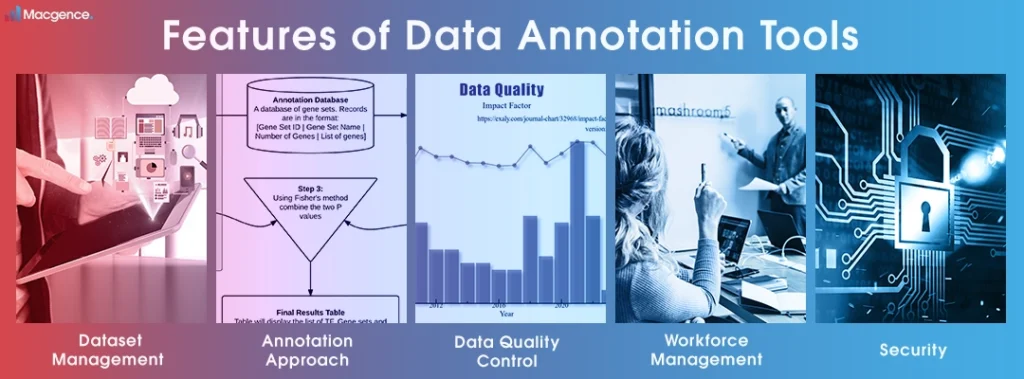
Each data annotation tool offers a wide range of features but we want to narrow them down to the basic features each tool should have. These basic features are necessary in order to train AI/ML models to produce high quality results. Let’s dive in.
Dataset Management
Every data annotation tool must support the following; import, export and ability to handle volumes of data. Reason is because it is the primary feature you need to manage your datasets.
Furthermore, the tool should be able to combine with your storage, and allow you to save your processed dataset in the necessary format needed for your AI/ML project.
Annotation Approach
This is focused on how your data annotation tool approaches a dataset. Actually, some data annotation tools are made to annotate some specific datasets; especially those that are built by some companies from scratch.
However, your data annotation tool should be design to handle large datasets of any kind. With your tool, you should be able to freely annotate text, audio, video, and images.
Another emerging feature for data annotation tools is AI-power annotation tools. These tools assist human annotators in filter and processing datasets. They also automatically check the final result for errors, hence improving the overall quality of the annotated data.
Data Quality Control
Emphasizing on the quality of your data cannot be over said. It ensures the results of your AI/ML models and we all don’t want our models to be full of errors. So these tools have quality check (QC) feature in their softwares. Actually, this feature helps annotators see feedback in real time and track activities done on the dataset.
Workforce Management
Even though most tasks are being replace by automation, we still need a human workforce. When dealing with large datasets, a data annotation that has a workspace where tasks can be assigned to fellow team members is important. This is why most leading tools incorporate this feature.
Security
While working with data of any kind, it is important that the data is secure. This is why your data annotation tool should have the following:
- Restricted access to team members and team leader
- The data should be stored in a secured vault, either on-prem or cloud based.
- Manage how the data is shared by not allowing unauthorized downloads.
- It should also restrict viewing rights to the data.
Benefits of Data Annotation
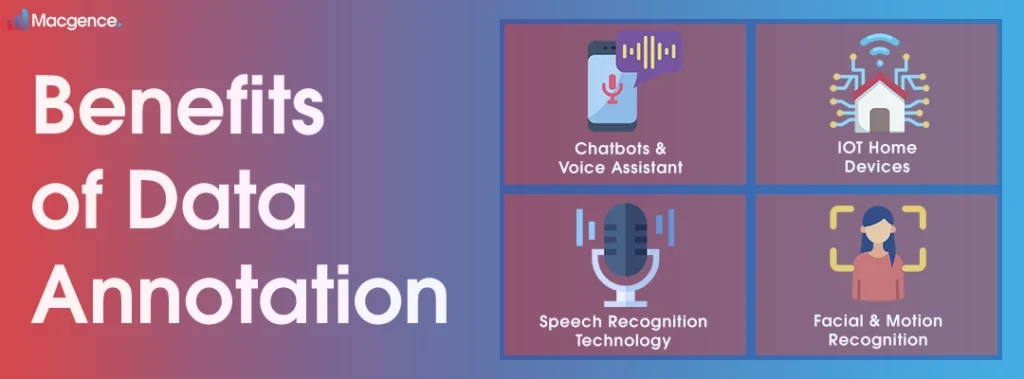
Data Annotation offers a wide range of benefits, enhancing the effectiveness and performance of AI and ML models in various applications. Firstly, data annotation improves the accuracy of machine learning models. By providing labeled data, models can learn from the examples and generalize to new, unseen data, leading to more precise predictions and better decision making.
Another significant benefit of data annotation is its enabling of supervised learning, a fundamental technique in AI. With annotated data containing input – output pairs, models can learn to map inputs to desired outputs, enabling them to make predictions and solve complex tasks. Supervised learning is prevalent in various domains, such as image classification and natural language processing.
Moreover, data annotation increase the efficiency of model training. Labeled data helps models converge faster during the training process, reducing the time and computational resources required for model development. This efficiency is crucial as it allows for faster experimentation and iteration, accelerating the pace of AI research and development.
Challenges of Data Annotation

Data Annotation comes with its fair share of challenges, which can pose significant hurdles in preparing labeled data for AI and ML models.
One of the primary challenges is the requirement for domain expertise and skilled annotators. Annotating data accurately demands knowledge about the specific task and an understanding of the domain. Without expertise, annotators may make mistakes or misinterpret the data, leading to flawed annotations.
Another challenge is the time and effort involved in data annotation. Depending on the complexity and scale of the task, annotating data can be a time consuming process. Annotators must meticulously label each data point, ensuring consistency and precision throughout the entire dataset.
Additionally, data annotation can be a costly endeavor. Hiring skilled annotators or using annotation services can incur expenses, especially for large scale projects or when dealing with specialized domains that require expert annotators.
Data Annotation in Specific Industries

It plays a critical role in specific industries, where labeled data is important to develop accurate and effective AI and ML models tailor to their unique needs.
- Healthcare Industry
In the healthcare industry, data annotation is crucial in medical imaging. Annotated medical images, such as X-rays and CT scans, allow AI models to assist medical professionals in detecting diseases, analyzing radiological images, and identifying abnormalities. This helps improve diagnosis accuracy and enables faster treatment planning, ultimately leading to better patient outcomes.
- Automotive Industry
In the automotive industry, data annotation is vital for developing self driving cars and advanced driver assistance systems (ADAS). Annotated data, including labeled objects and road signs, help autonomous vehicles perceive their environment and make informed decisions for safe navigation. It allows AI models to recognize pedestrians, other vehicles, and obstacles, ensuring safe and reliable autonomous driving.
- Retail Industry
In the retail industry, data annotation is significant for visual search and recommendation systems. Annotated product images enable AI models to recognize and match similar products, improving search accuracy and enhancing the overall shopping experience. Additionally, personalized recommendation systems benefit from annotated customer data, allowing AI models to suggest relevant products to users, boosting customer engagement and sales.
- Finance Industry
In the finance industry, data annotation is crucial for fraud detection and risk assessment. Annotated transaction data allows AI models to identify fraud activities and flag suspicious transactions, helping financial institutions prevent fraud and enhance security. Furthermore, annotated historical financial data enables risk assessment models to make informed predictions and optimize investment decisions.
- Manufacturing Industry
In the manufacturing industry, data annotation is important for quality control and defect detection. Annotated data from visual inspections allows AI models to detect defects in manufactured products and identify deviations from quality standards. This aids in maintaining product quality and minimizing production errors, ultimately reducing costs and improving efficiency.
What Data Annotation Tool to Use (Build or not Build)?

While data annotation is one thing, another issue is choosing whether to build or send your process to a vendor. But the truth is that there are pros and cons to any choice you make.
There are a lot of factors to consider while making this decision, but we will help streamline your thought with some of these points:
- Define Your Reason: Before going on any journey, there must be a clear reason as to why you decided to hit the road. Same thing can be applied here. To know if you are to build or not build, you have to know what you want to use your AI/ML model for? What problem are you trying to solve? These are a few questions to set your thoughts on the right part.
- Where to Source your Data: As you likely know, all AI/ML models need data. Now, how and where do you get your data? You need to know where to get large true data sets. Also if your business already create massive data sets, you need a data annotation tool. This will help you, filter, analyze and do much more, however you want it to be process.
Subsequently, if you can’t collect data for your AI/ML model, then you can look to send your data annotation to vendors who offer such services. This is where we at Macgence, thrive in making sure your data annotation process is of the highest quality. - Budget: Well it goes without saying that having a budget is crucial. In fact, it is the most important factor to consider because you need money to build a data annotation tool or send it.
- Staff Power: Also, your team or employees will play a role in deciding whether or not to build a data annotation tool. The skill level of your staff will help in how the data you receive or generated is use in your AI/ML model or business. Actually, having a team of experts will help you in any choice you end up making.
- Size of your data: So depending on the volume of data, that you need, will determine if you build or not. Oftentimes, sending your data to vendors can be beneficial and more affordable for your projects. It is worth considering.
Best Practices for Data Annotation

Best practices for data annotation are important to ensure the quality and reliability of labeled datasets, which, in turn, contribute to the effectiveness of AI and ML models. Some of the best key practices to consider are:
- Clear Guidelines and Instructions: Providing clear and comprehensive guidelines to annotators is crucial. Clearly define the annotation task, label categories, and any specific rules or conventions to maintain consistency across annotations.
- Domain Expertise: Assigning annotators with domain expertise in the relevant field ensures accurate and informed annotations. Expert annotators are better equipped to handle domain specific challenges and make informed decisions during the annotation process.
- Quality Control and Review: Implement a robust quality control process to validate the accuracy and consistency of annotations. Conduct regular reviews and audits to identify and rectify any discrepancies or errors in the labeled data.
- Handling Ambiguity: Some data points may be ambiguous or require subjective judgment. In such cases, provide guidelines on how to handle uncertain or complex scenarios to ensure consistent annotations.
- Data Privacy and Security: Adhere to data privacy regulations and protect sensitive information during the annotation process. Annotators should be aware of data confidentiality and take necessary precautions to safeguard data.
- Continuous Training and Improvement: Regularly train annotators on best practices, new guidelines, and emerging annotation techniques. Keeping annotators updated ensures high quality annotations and improves the efficiency of the annotation process.
Difference Between Data Annotation and Data Labeling
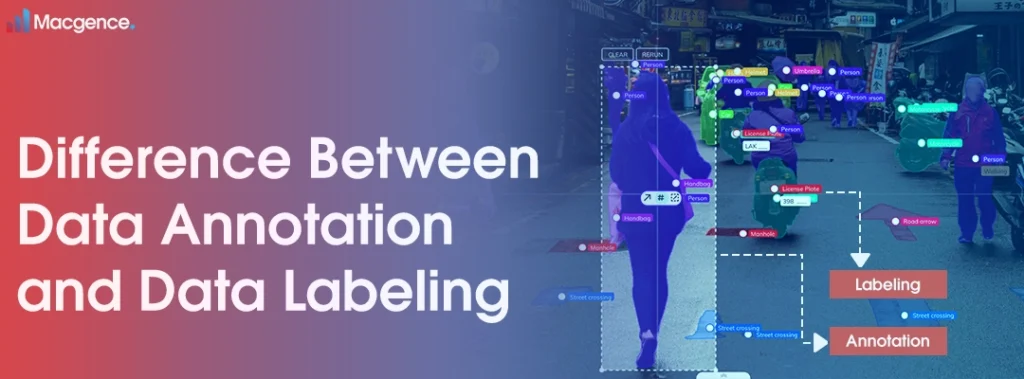
Oftentimes, data annotation and data labeling have been used interchangeably but there is one significant difference between them. Since the rise of artificial intelligence, everyday humans are training machines to be able to act the way we humans do. Additionally, to train these machines—data is needed.
Data is known to come in various forms like text, audio, images, and videos. However, to increase the quality and accuracy of the data, it must be labeled or tagged. So, data labeling, simply put, is the process of tagging single sets of data. While this is the process of adding metadata to sets of data. To put in simple terms, data labeling is done before data annotation.
Conclusion
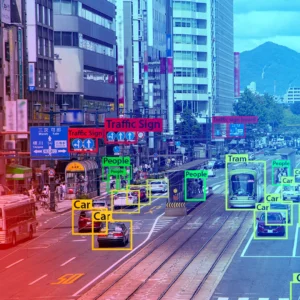
In conclusion, It plays a crucial role in various industries by providing labeled data for training machine learning models. It helps improve the accuracy and effectiveness of these models in solving real world problems. Despite its importance, data annotation comes with challenges, such as ensuring quality and scalability. However, adopting best practices and leveraging automation can mitigate these issues. As the demand for labeled data grows, data annotation will continue to evolve with advancements in AI-assisted tools and techniques. Embracing effective data annotation practices will undoubtedly contribute to better outcomes across different domains, making it an indispensable aspect of the modern data driven world.
Get Started with Macgence
Get started with Macgence, your ultimate destination for human generated data annotation solutions. Our services encompass text, image, video, and audio annotation, catering to all your machine learning and AI endeavors. With Macgence, you’re assured of scalability, allowing us to handle projects of any size, and ensuring on-time delivery. We take pride in providing superior annotation quality, as our skilled annotators meticulously label your data to optimize model performance. Our commitment to zero internal bias ensures fairness and neutrality in annotations, enhancing your AI systems’ integrity. Regardless of your industry, Macgence’s cross industry compatibility ensures customized solutions tailor to your specific needs. Start today and experience the power of human generated data annotation at Macgence.
Frequently Asked Questions (FAQ’S)
Q1. What is the future of data annotation?
Q2. What are the types of data annotation?
Q3. Is data annotation a technical job?
Q4. What is the difference between data labeling and annotation?
Q5. What is an example of data annotation?
Q6. What is the role of data annotation?
Q7. What are skills of data annotation?
Attention to detail: Data annotators must be able to identify and label the relevant features in the data accurately and consistently.
Domain knowledge: Data annotators must have a good understanding of the domain of the data that they are annotating.
Technical skills: Data annotators must be proficient in the use of tools and technologies for data annotation.
Communication skills: Data annotators must be able to communicate effectively with their team members.
Problem-solving skills: Data annotators must be able to identify and solve problems as they arise.
These are just some of the skills that are essential for data annotation. If you are interested in a career in data annotation, it is important to develop these skills.
You Might Like
February 28, 2025
Project EKA – Driving the Future of AI in India
Artificial Intelligence (AI) has long been heralded as the driving force behind global technological revolutions. But what happens when AI isn’t tailored to the needs of its diverse users? Project EKA is answering that question in India. This groundbreaking initiative aims to redefine the AI landscape, bridging the gap between India’s cultural, linguistic, and socio-economic […]
April 7, 2025
Explainable AI (XAI)
Artificial intelligence (AI) is changing sectors in a number of ways, like by influencing security, healthcare, and financial choices. However, questions concerning the reliability and moral implications of many AI models have been highlighted by their opacity. Explainable AI (XAI) provides insight into AI decision-making in this situation. XAI makes it possible to comprehend, validate, […]
April 5, 2025
The Ultimate Guide to Geospatial Data Collection Providers
Geospatial data collection has become an essential part of modern industries, playing a vital role in urban planning, environmental monitoring, transportation, agriculture, and defense. With the advent of advanced technologies such as artificial intelligence (AI), satellite imaging, drones, and LiDAR, the geospatial industry is witnessing a rapid transformation. In this blog, we will explore some […]
April 1, 2025
The Strategic Benefits of Partnering with Macgence for Model Evaluation and Validation
In the rapidly evolving AI landscape, ensuring robust model performance is not just an advantage—it’s a necessity. For businesses leveraging AI/ML technologies, partnering with a specialized validation partner like Macgence can mean the difference between unreliable prototypes and enterprise-grade AI solutions. At Macgence, we bring unmatched expertise in AI model evaluation and validation to help […]


